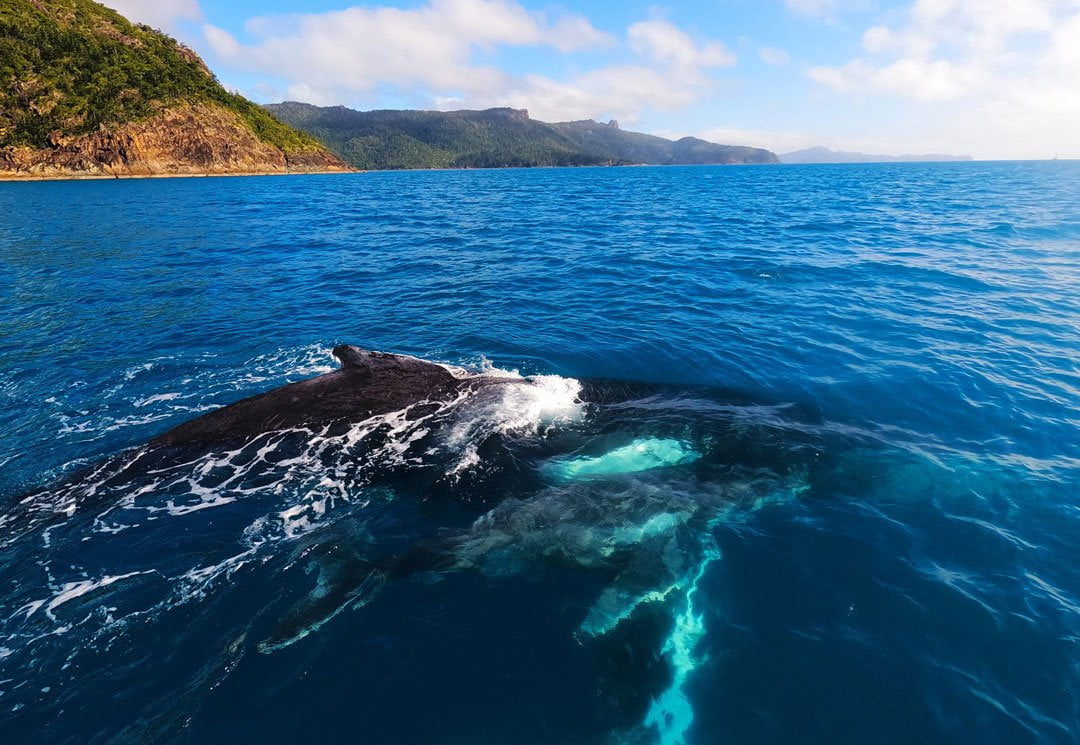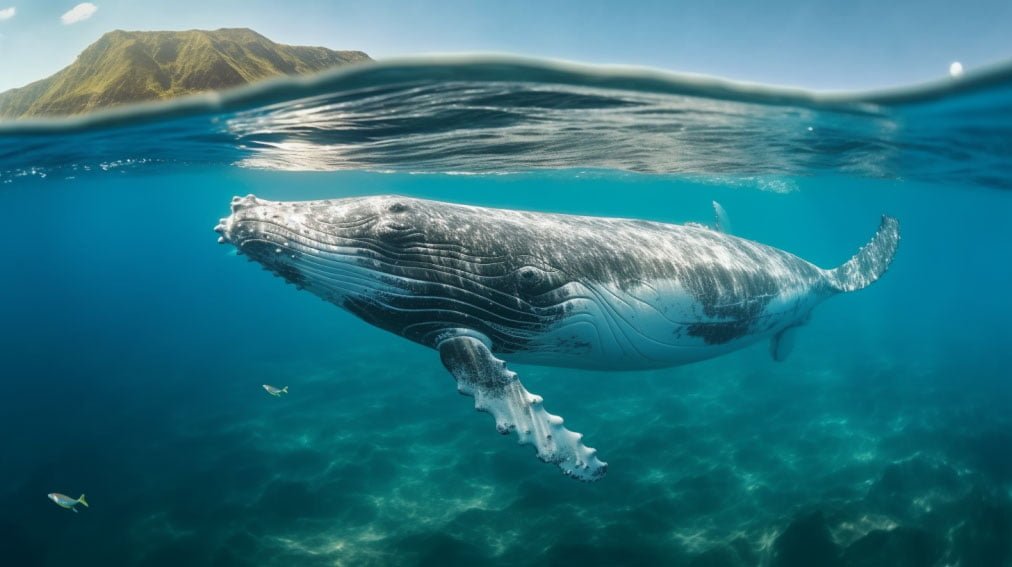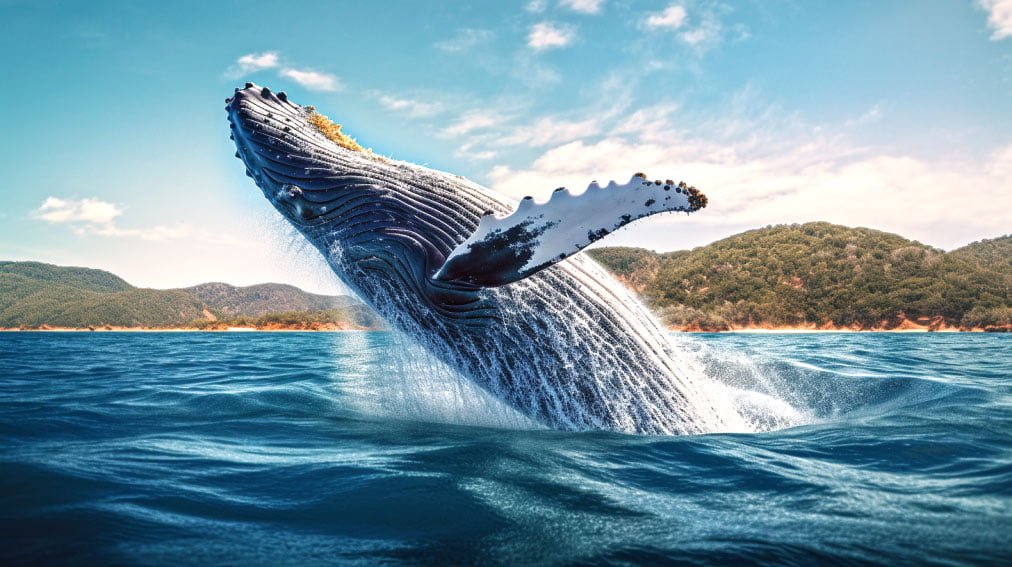WHALES IN THE WHITSUNDAYS
© Official Local Whitsundays Website
The majestic Humpback Whale (Megaptera novaeangliae) is an awe-inspiring sight to behold in the Whitsundays region of Australia.
Every year, this species follows an impressive 8000km migration route to mate, calve and nurse their young in the warm waters of the Whitsundays.
They are renowned for their impressive filter-feeding capabilities, enabling them to thrive in both cold and productive waters.
In this article, we explore the incredible life stages of the Humpback Whale as they migrate through the Whitsundays region, including family dynamics, surface active behaviour and whale song.
Additionally, we will discuss any potential threats that may affect these magnificent creatures during their journey.

Whales in the Whitsundays
Every year, Megaptera novaeangliae migrate to the Whitsundays to mate, calve and nurse their young in the warm waters, before returning to the Antarctic waters for feeding during summer. The Whitsundays provide an ideal habitat for these animals due to its shallow bays and warmer climate. This makes it a valuable location for our Humpback population, which has led to extra protective measures being put in place such as increasing the safe distance between whales and boats from 100m to 300m.
Humpbacks are known for their impressive migratory patterns, travelling up to 8000km during their annual journey. They are also capable of scooping massive amounts of seawater and prey such as krill, copepods and small fish into their mouths due to their throat grooves expanding.
Conservation efforts have been implemented across various locations including protected marine parks and sanctuaries with regulations on boat movements in order maintain healthy populations of humpback whales within this region annually. Monitoring activities are conducted regularly through surveys such as aerial flights or water-based research conducted by experienced observers ensuring that appropriate action can be taken when needed in order safeguard these gentle giants against threats posed by human activity or environmental changes.

Life Stages
Humpbacks, (Megaptera novaeangliae), progress through distinct life stages, from calves to sub-adults, and finally reach full maturity at around eight years old.
Calves are born weighing up to one tonne after a gestation period of 11.5 months and nurse for five months to a year. During this time they can consume up to 10% of their body weight daily and grow to 8-9m before beginning their migration back down south.
Juveniles or yearlings (1-2 years) wean from their mothers and begin associating with other adolescent whales – males forming ‘bachelor pods’ whilst the females tend to leave and then return to their mothers.
As they reach adolescence, they will leave their pods in either groups or pairs before reaching sexually mature adult status between 5-8 years old. At this point, they are equipped with the knowledge required for breeding habits, migratory patterns, nursing behaviors, social interactions and feeding strategies that shape the entire population of Whitsunday humpbacks.
Sub-adult Humpbacks between 2-5 years old practice these skills until full maturity is reached at approximately 8 years; allowing them to live up to 50 years when all life stages have been complete.
Through each stage the humpback whale develops essential capabilities that enable it survive in its environment as well as contribute positively towards its ecosystem.
Family Dynamics
Family dynamics among humpbacks commonly involve the formation of ‘bachelor pods’ by males, and lone females or cow-calf pairs trailed by ‘escorts’, with the nearest male deemed as the ‘principal escort’.
Humpback whales are highly social animals and exhibit a variety of complex behaviours for communication, such as breaching, tail slapping, head-butting and vocalizations.
Breeding habits vary between individuals but generally consist of males competing for access to a female in estrus. This competition is characterized by physical contact between consenting males, which typically results in the leading male becoming the principal escort.
Social structure within these bachelor pods also consists of secondary escorts that trail further behind and are not directly involved in competition for access to females.
Feeding patterns amongst humpbacks involve filter-feeding on krill, copepods and small fish. These whales migrate each year from their Antarctic feeding grounds to calve and nurse their young in warmer waters like those found around Australia’s Whitsundays region.
During this migration they travel up to 8000km along predetermined routes determined through generations of experience passed down through matriarchal lines.
Communication plays an important role during these migrations as it can be used to coordinate movement within large groups or alert other members about potential danger from predators such as orcas or sharks.
Vocalizations produced during mating season are also believed to be an essential part of mate selection, with individual whales possessing unique dialects that may help identify them within larger populations.
This ability to communicate via sound is essential for survival amongst humpback populations so that they can maintain successful family dynamics whilst travelling long distances during migration seasons.

Surface Active Behaviour
Surface active behaviours of (Megaptera novaeangliae) such as blow, breaching, tail fluke up dive, fin slapping, tail slapping and peduncle throwing, are important for communication amongst this species.
Breaching displays are often used to signal social interactions or initiate bubble blowing. Tail slapping is a common cue to indicate an individual would like some space, while spy hopping allows a whale to see what is happening above the waterline.
These behaviours are vital for the whales’ communication and serve as exciting visuals when observed by humans in the Whitsundays. The blow can reach up to 4m in the air and is typically seen when whales come to take breaths before diving below again after 45 minutes.
Breaching can be used as a competitive ritual between males competing for mating rights with a female, or it can be used as a means of communication. Tail flukes allow us to identify one whale from another due to its unique pattern on each individual.
Fin slapping helps rid their pectorals of parasites, and tail slapping can be done repetitively as a warning sign. Lastly, a Peduncle throw involves throwing its tail out of the water & slaps its peduncle (area between the dorsal fin & tail fluke) on the surface of the water, which also serves as an enjoyable visual experience for observers on boats at sea.
Humpback whales display these various surface active behaviours during their annual migration through the Whitsunday Islands waters, making them a fascinating species to observe and learn about whilst visiting this region. It’s easy to appreciate why so many people flock here year after year during Whale season – there’s nothing quite like seeing these majestic creatures in their natural environment!
Whale Song
During their annual migration, (Megaptera novaeangliae) often employ complex songs in order to attract potential mates. Whale song is a form of vocal communication used by humpback whales which consists of a series of acoustic patterns that are transmitted through the water.
These songs can be seen as a cultural transmission between male whales and have been observed to change gradually over time. Humpback whale singing has also been shown to be associated with mating behaviour, as males sing more frequently during the breeding season in order to attract females.
Humpback whale songs feature several different components, including moans, howls, cries and whistles. Each component is composed of distinct acoustic frequencies, which range from 0-20 Hz for low frequency sounds such as grunts and clicks all the way up to 20 kHz for higher frequency calls such as squeaks and whistles.
This wide range of frequencies allows the whales to communicate across large distances even underwater with minimal interference from other sources. The structure and complexity of humpback whale songs vary depending on where they are located within their range.
In the Whitsundays, these vocalisations tend to be longer than elsewhere due to the presence of multiple breeding grounds where males compete for potential mates. This means that in this region, researchers have observed some of the most intricate vocalisations ever recorded from humpbacks – providing valuable insight into the social lives of these magnificent creatures.
Threats To Whales
Humpback whales face numerous anthropogenic threats to their population, including:
- Entanglement risks due to fishing nets or shark nets left in the ocean can cause injury and death.
- Hunting history, which has reduced global populations of humpbacks in the past.
- Shipping dangers posed by vessels passing through whale habitats can cause collisions.
Noise pollution is another major threat facing humpback whales as they rely on sound for communication. Anthropogenic noise generated by ships and other sources can interfere with a whale’s ability to communicate and navigate its environment.
Climate change is also having an increasingly negative impact on the health of the oceans and therefore affecting whale populations through food availability and ocean acidification. Rising sea temperatures are believed to contribute to the mortality of some whale calves during migration season due to extreme stress or lack of food resources.
The conservation of humpback whales should be taken seriously, as these majestic creatures face far too many threats from humans alone for them to recover without help. With increased awareness about their plight comes a greater understanding of how our actions have consequences for marine life throughout the world’s oceans.
Frequently Asked Questions
What is the best time of year to see whales in the Whitsundays?
Humpback whales migrate seasonally, typically to warmer waters for mating and calving. The best time of year to view these creatures in the Whitsundays is generally between mid June to early September, when they follow their traditional migration routes towards birthing areas.
How long does the migration of humpback whales last
Humpback whales have an annual migration lasting up to 8000km, influenced by social behaviours, mating rituals, habitat preferences, ocean conditions and seasonal changes. They spend only minimal time in the Whitsundays from June to September and back towards the Southern Ocean from September to November
How often do humpback whales reproduce
Humpback whales breed annually, with a complex mating ritual and song. Females give birth to one calf per season, which they then care for until the next breeding cycle. The complexity of their songs is believed to increase the chances of successful mating and calf survival.
How do humpback whales communicate with one another?
Humpback whales use a variety of acoustic signals to communicate with one another, such as socializing patterns, breeding behavior and migration routes. These vocalizations are used to coordinate mating activities at calving grounds. Additionally, the whales can also communicate via physical contact or gestures.
Are there any specific conservation measures in place to protect humpback whales in the Whitsundays?
Humpback whales in the Whitsundays are protected by various conservation measures, and you can find all the information on whale protection in the Great Barrier Reef Marine Park here.
[forminator_form id=”244492″]
Hi, I’m Nath J, a long-time local who’s been lucky enough to live and work tourism in the Whitsundays since 2001.
Over the past two decades, I’ve helped visitors discover the best of this incredible region, from Whitehaven Beach and Hill Inlet to the hidden spots only locals know about. I started out managing boats and tours, and these days I run Ripple Effect Online, a tourism-focused digital marketing business helping local operators grow and connect with travellers like you.
I’ve written an ebook called Whitsunday Islands: A Journey through Paradise, created countless local travel guides, and earned recognition as a “Whitsundays Tourism Hero” from QTIC for my contribution to the region and gained First Nations Cultural Protocol training through QTIC as well. But more importantly, I’ve spent years listening to travellers, understanding what makes a trip unforgettable, and helping people plan the kind of experience they’ll talk about for years.
If you’re planning a visit to Whitehaven Beach or anywhere in the Whitsundays, I’m here to help you make it amazing.
Find me on Facebook and LinkedIn or drop me an email at info@nath-j.au.
